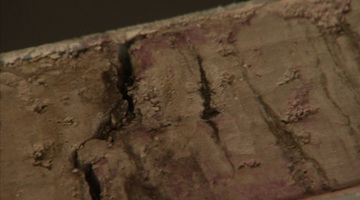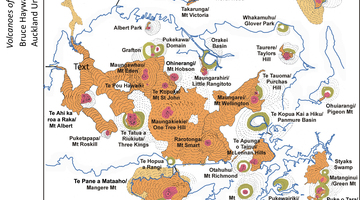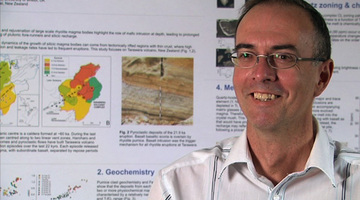Dr Phil Shane takes us through a rock core – a sample of rock going back tens of thousands of years that details events such as volcanic eruptions.
Transcript
DR PHIL SHANE
Here we’ve got a section of core taken from Onepoto Basin. This is just a metre and a half section taken from about 65 metres below the surface. It’s obviously just one section but it gives a nice example of what lake sediments are like and at least some of the tephra layers or ash layers – we refer to ash layers as tephra layers.
Here at the top of the core in this core section, this is the youngest part, and as we move down the core, it gets older. At the top, we can see this brown laminated – that‘s those fine lines like little layers of laminated sediment. You could imagine them almost like, I guess as geologists, we almost imagine them as like pages in a book. They are sort of a continuous record of what is deposited either every year or every decade over time.
As we come down the core, we see this thick black layer here – it’s a little bit coarser grained. And this is basaltic ash from a local Auckland eruption. And then we come down again, we move deeper, we move back into this laminated embedded lake sediment. You see there’s even some fine layers like that. That’s a volcanic ash layer from Mt Taranaki.
Further down now towards the base of this core, we are about 65 metres down now, we see all this white material, and this is rhyolite ash from Okataina. Okataina is a large rhyolite volcano near Rotorua. This was a particularly big eruption. It produced a large crater or caldera – that’s a large collapsed structure – down at Okataina. It’s referred to as the Rotoiti eruption. It happened between about 50 and 60 thousand years ago.
Because we can geochemically fingerprint these sorts of ash layers, they also become marker beds for us to be able to work out the age of this core. So we know at this depth, we are back about 50,000 years ago. You can see from the thickness of the ash here – it could be something like 50 centimetres thick – it must have been a very big eruption. And in fact, we are 60 metres below the ground here, so the sediment would have compacted this ash down, so the original thickness of ash would have even been greater.
So if we are up in Auckland and we are getting 10–50 centimetres of ash around the landscape 60,000 years ago, that means it was a very big eruption. This sort of eruption would have resulted in blocking out of sunlight through the day. Even in the middle of the day, it would be like walking around in darkness. There would be fallout of ash – it’s not just fine material falling out – it sort of cakes together like snowflakes. It would be coming out of the sky, fluffy snowflakes of ash, mantling the landscape. It would be very difficult to breathe, it would be dark, it could be warm and humid. You wouldn’t be able to drive, vehicles wouldn’t be able to operate with this amount of material in the atmosphere and, of course, aircraft. It would be a major hazard to aircraft – you wouldn’t be able to fly in and out.




